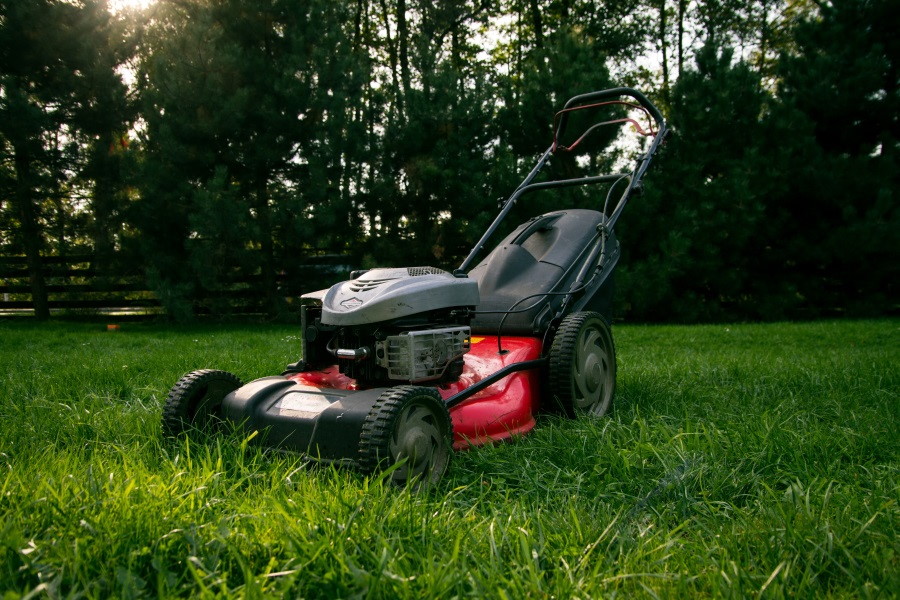Lawn & Landscape
Summit County LawnsBest Lawn Tips To Improve Your Summit County Lawn & Landscape.

1. Taller Grass Equals Longer Roots Equals A Healthier Lawn.
How tall your grass is a great indicator of the depth of the roots. So, if you want great roots, you need tall grass. The standard is to cut off only 1/3 the height of the grass each time to allow the plant to recover and grow stronger. Additionally, longer grass reduces evaporation and keeps weeds from accessing soil, light and water before the weed seeds germinate.
Remember the 1/3 rule, no matter how tall your grass is. One of the easiest ways to harm your lawn is to scalp or “buzz cut” your lawn. Once the soil is exposed the lawn dries out faster, which can lead to a dry lawn and lets the weed seeds thrive.
2. Sharp Lawn Mower Blades Equals A Clean Cut
Always remember to keep mower blades sharp. How often? Try to shoot for sharpening at least 2 times during the season if you cut weekly. Dull blades tear grass and fray ends, leading to dried out lawns and making lawns susceptible to insects and diseases. The good news is lots of websites such as YouTube offer lots of online videos that show you how to sharpen your lawn mower blades at home.
3. Grass mulching or “Grass-cycling”
Well you grew the grass, why not put grass clippings to work and keep them out of landfills. Grasscycling is simply recycling and mulching grass clippings by leaving them on the lawn and allowing them to simply “compost” in place. Clippings have lots of nutritional value for your yard and really too valuable to discard. Think of its as free fertilizer, which can provide up to 25% of the fertilizer you need for a green lawn. Furthermore, living in an area with shortened growing season such as Silverthorne or Frisco, it’s best to get the thickest grass you can to help build up your soil base by allowing the clippings to quickly breakdown and release nutrients back into the soil. Moreover, the organic matter promotes a healthy soil ecosystem.
4. Maintain a Consistent schedule for fertilization.
Fertilize when it’s right for your lawn. Some fertilizers may cause your lawn to grow quickly, requiring you to mow your lawn more frequently, particularly right after fertilizing. Some fertilizers are slow-release to keep your lawn growing at a steady pace.
Tips on how to fertilize the lawn from Briggs & Stratton:
- Buy a high quality fertilizer spreader.
- Apply fertilizer on freshly mowed grass when it isn’t windy and there is a light dew still on the ground. This will help the fertilizer spreader evenly distribute, leaving visible tracks of where the fertilizer has been applied.
- Most fertilizer rotary spreaders cover a swatch of grass around 6 to 8 feet wide. For big yards, set surveyor flags to provide reference points.
- To apply fertilizer evenly, cut the amount used in the rotary spreader in half. Then apply in opposite walking directions. This trick, used by the pros, is the biggest reason why you don’t see streaks caused by too much fertilizer in golf course grass or baseball fields.
- For even fertilizer distribution, start walking before turning on the rotary spreader and shut it off before you stop walking.
- Be sure to wash the fertilizer spreader after use. Because of its salt properties, most fertilizer is very corrosive.
- Water the lawn. Improve the fertilizer’s efficiency by watering the lawn soon after an application. Better yet, try to apply fertilizer just before it rains.
5. Cut Grass At Cool, Shady Time To Reduces Stress.
When possible, mow areas of the lawn when they’re in the shade or the entire lawn during cooler times of the day. Grass loses less water and it reduces heat stress.
6. Borders and Edging Make Mowing Faster, Easier and Cleaner
Creating borders and providing edging around your garden bed can help separate the garden from the lawn, creates an aesthetically attractive edge to prevent mulch, rocks, etc. from spilling into the lawn. Additionally, it will truly make weed whacking and mowing far easier and while requiring less time.
Edging materials are available to fit a wide budget range. From dead trees, rocks, and stones, to poured concrete and concrete pavers, there are an unimaginable number of possibilities. You can also finds a wide variety of colors and textures to match the style of your home and yard.
